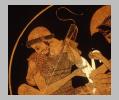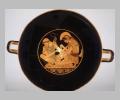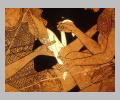| Collection: | Berlin, Antikenmuseen |
| Summary: | Interior: Achilles tending the wounded Patroklos |
| Ware: | Attic Red Figure |
| Painter: | Name vase of the Sosias Painter |
| Potter: | Signed by Sosias |
| Context: | From Vulci |
| Date: | ca. 500 BC |
| Dimensions: | H. 0.10 m; Diam. (mouth) 0.32 m |
| Primary Citation: | |
| Shape: | Kylix |
| Beazley Number: | 200108 |
| Region: | Etruria |
| Period: | Late Archaic |
Condition: The kylix is in fairly good condition, although the surface has suffered some wear.
Decoration Description:
Interior: Achilles and Patroklos. Achilles bandages Patroklos' arm. Patroklos, who has been wounded in the upper left arm, sits on his shield, his right knees splayed outward and his left leg extended with his foot braced against the outline of the tondo. The elbow of his injured arm is supported on his left thigh. He holds the bandage with his right hand, and turns his head away from the injury. Achilles stoops at his friend's side, wrapping the bandage around Patroklos' arm with both hands, his full attention on the wound. He wears a short chiton, a skirted cuirass, a crested helmet and sandals. The cheek-pieces of his helmet are turned up. Patroklos, who is bearded and has a thin mustache, wears a short chiton, a skirted cuirass and a tight cap which covers the crown of his head and formed a cushion for his helmet. His quiver hangs over his left shoulder. An arrow (taken from his arm?) rests against the outline of the tondo on the far left.
The drawing of the eyes of Achilles and Patroklos is unique: they are not shown frontally, as on most contemporary vase paintings, nor in the conventional profile view of later painting, but are rendered very realistically (and somewhat unnaturally large), adding greatly to the pathos of the scene. (The eyes of the figures on the exterior of the cup are rendered in the conventional manner.)
Exterior, sides A and B: Herakles entering Olympos. A procession of gods and goddesses accompany Herakles in a procession which moves toward Zeus and Hera, sitting side by side on the far left of side A. Next to Zeus stands an adler-crowned scepter; Hera holds a thick staff. Poseidon and a goddess sit facing them, the latter holding a large fish. Poseidon holds a short staff. A winged goddess standing between the pairs of gods pours liguid from a trefoil pitcher into the phiale Hera holds. She wears a chiton, mantle and sakkos. The pair of seated gods behind Poseidon and Aphrodite is Ares and Aphrodite. Behind them sit Dionysos and Ariadne or Semele. Dionysos holds a grape vine. His companion wears a veil. The thrones of the seated gods are lion-footed and are covered with panther skins. All hold phiales. On side B, the three Horai continue the procession, the first carrying a a grape vine, the second a branch from a pomegranate tree and a smaller branch with some other fruit (lemons or quince), the third one piece of red fruit, probably an apple. Next are two seated goddesses. The one in the foreground in labelled Amphitrite, though the goddess next to Poseidon on side A could also be identified as Amphitrite. Her companion, who wears a veil and has thrown her arm around Amphitrite's neck, is Hestia. Amphitrite holds a Thyrsus. As on side A, the seated gods hold phiales. Behind the seated goddesses is Hermes Kriophoros. He holds a sceptre in addition to the young ram, and wears his winged boots and a mantle. Behind him is a figure with short hair dressed in chiton and mantle and carrying a lyre who could be identified as Apollo if he were not labelled Artemis. Herakles can be seen second from the left carrying his club. His right hand is raised, with the palm upward, his fingers cupped. He is wearing a short, belted tunic and his lion skin; a quiver hangs at his waist. Behind him walks a young goddess holding a staff, her hand on Herakles' shoulder. Although without attributes, she can probably be identified as Athena. She wears a chiton, mantle and a fillet. The mantle is pulled partially over her head. Behind her, under one handle is the moon, Selene, represented by a woman's head and hand in a disk. She wears earrings, a fillet and a necklace.
Shape Description: For the shape see Bloesch 55-56.
Inscriptions: On the interior,
Collection History: The vase was found in 1828 in Vulci, Camposcala, by Fossati. It was acquired by Magnus, and came to Berlin in 1829 with the Dorow'schen collection.
Sources Used:
Other Bibliography:





